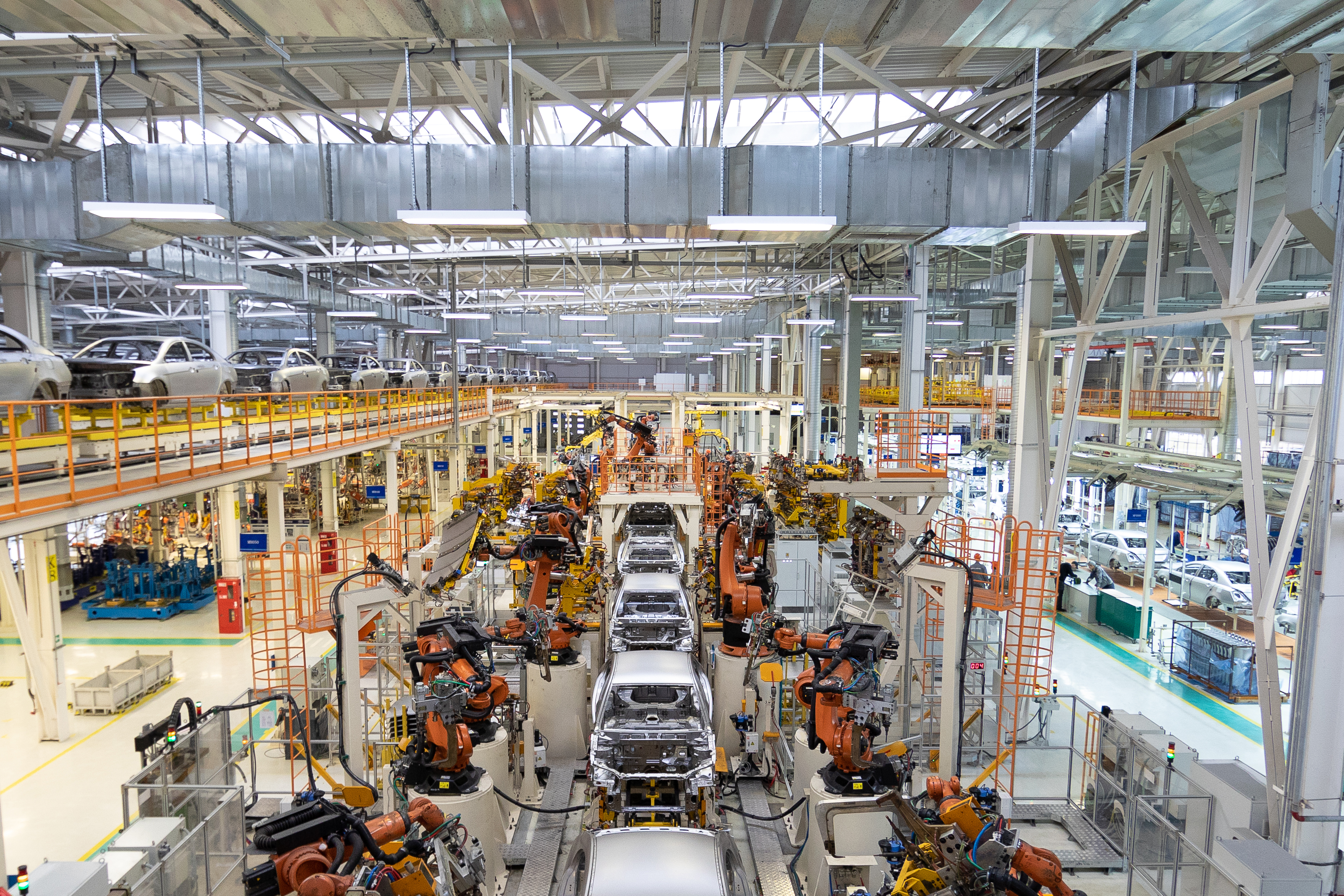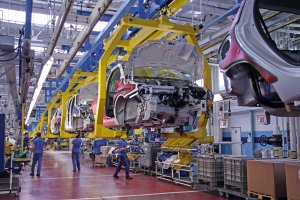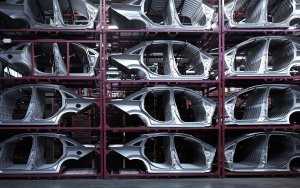The automotive industry is undergoing a radical transformation. New social, technological, environmental, and geopolitical challenges are redefining the characteristics of a saturated market, opening new scenarios while offering opportunities for the entry of new players. These challenges are bound to trigger reorganization of the global value chain between old and new suppliers, affecting the distribution of employment, the regionalisation of production and the dynamic evolution of the comparative advantage of nations.
Existing car manufacturers in the US, Europe, and Japan have accomplished a hierarchical regionalisation of production and trade: the Original Equipment Manufacturers (OEMs) have delocalised production facilities in neighbouring countries, forming a tight network between core regions and their semi-peripheries and integrated peripheries (Krzywdzinski, 2020). China has become one of the largest car markets and still remains a competitive producer of automotive components and parts.
In our new paper we address the issue of the reorganization of these global value chains in the face of various challenges: new, large markets opening up and fresh, aggressive competitors emerging; an increasingly unpredictable global geopolitical context, translating into the forging and undoing of trade agreements; the reorganization of value chains induced by new digital technologies; the redefinition of what a “car” is, determined by electrification and increasing automatic control of driving. These simultaneous changes affect the geographical location of the industry, the distribution of power within the value chains, and between incumbents and new players entering the industry (from energy firms and power utilities to battery producers and big tech monopolists), with obvious consequences for the distribution of production and employment across countries and within manufacturing and service sectors.
In the first wave of restructuring that started in the 1990s, the big carmakers exploited the strategies of peripheral countries’ governments aiming at attracting foreign direct investments (FDI) through cheap labour and fiscal concessions, while taking advantage of their geographic proximity to large markets and their participation in regional trade agreements. The main producers of components (the “tier one” suppliers) followed their customers in their delocalisation. The end result was a highly globalised industry, organised in macro-regional clusters of production networks, such as US-Canada-Mexico in North America, Germany-Southern and Eastern European Countries in Europe, Japan-China-Korea and East Asian countries, and Brazil-Argentina in Latin America (Russo et al. 2020).
While countries in these “integrated peripheries” saw incredibly fast growth in production, especially in components and parts (Pavlínek 2018), traditional core countries - Canada in North America and many countries in Europe, with the exception of Germany - lost ground in domestic car production. Competition through labour costs and government incentives in the integrated periphery put pressure on labour in the higher wage core countries. Due to cost competition they suffered a process of delocalisation of many production phases, slipping down into what has been called a “semi-periphery” (Mordue and Sweeney 2020), denoting countries that lack (or have lost) a domestically headquartered carmaker. Survival of their value chains relies basically on the ability to move to high value, high research and innovation products. However, empirical studies on the automotive industry found that R&D tends to concentrate in locations proximate to corporate headquarters (Mordue and Sweeney 2017). Thus, for countries or regions lacking a global flagship, generating R&D can be problematic. The risks faced by the industry’s old core are compounded by the transition to electric vehicles (EV) and autonomous driving (AV), which entail a radical change in the quantity and quality of components. The survival of these industries relies on their ability to reinvent themselves, embarking on frontier technologies that have less to do with the traditional automotive industry but, for this very reason, are less developed in these countries. This is particularly true of software and digital technologies, which are concentrated in regions other than those dominated by incumbent carmakers.
The integrated peripheries face similar challenges. Foreign investments provided a positive contribution to the growth of production and exports as well as direct and indirect creation of jobs. However, production, organization, and strategic functions are externally controlled through foreign ownership, and there seems to be little evidence of positive spill-over effects on domestic industry. In this model of dependent development, although their automotive industry is based on state-of-the-art factories and technologies, the long-term sustainability of their development faces serious challenges. On one hand, since automotive supplier networks are by now fully established in the Eastern European Countries, new investments in the components industry are likely to continue at a significantly lower rate than in the period prior to the 2008-2009 economic crisis. On the other hand, the electric and digital transformation may represent an even greater risk for the productive structure of these countries, which is particularly focused on engines, transmissions and mechanical parts, and even more so since investment in these new fields depends on the decisions of external actors.
Mexico represents a significant case for analysis of the impact of the digital transformation on the domestic value chain in an integrated periphery, and of trade agreements on the location policies of big multinationals. The country is heavily dependent on FDI for the development of its automotive industry, and, according to some scholars (Castellanos et al. 2010; Carrillo 2018) the foreign-owned, technologically advanced part of the industry has been insulated from the rest of the value chain in Mexico. The dependency of the Mexican automotive industry on the strategic decisions of global players is considered a factor of great vulnerability, especially in a context of rapid change in the patterns of consumption, technologies and international trade agreements.
As for the latter, although the conclusion of the new Treaty between the US, Mexico, and Canada (the USMCA Agreement) brought relief to Mexican companies and policymakers and raised optimism about prospects for new investment inflows, its effects are far from certain. The new, stricter conditions on rules of origin of the Treaty will attract new firms willing to divert production from other developed or emerging economies to gain access to the US market, while taking advantage of cheap Mexican labour. Indeed, the labour clauses of the Treaty do not seem to have worried producers in Mexico too much, so far. On the other hand, digital technologies could play a key role in starting a sweeping transformation along the entire supply chain, providing better quality control and smoother flow of information within supply chains with just-in-time production, enhancing product quality control together with process and product innovation. They could also provide the flexibility required to optimize the production process without relying solely on labour flexibility, which has so far been the main resource for adjustment. To meet these challenges, changes are needed in several interrelated domains that go beyond digital traceability of products and processes: labour up-skilling, energy and digital infrastructure, logistics and integrated modernization of transport.
For Mexico, as for European producers in the integrated and semi-peripheries, the main challenge in the near future will be posed by the radical transformation the industry is going through in electrical and autonomous-driving vehicles, which sees regions and players outside the traditional automotive clusters in the lead. Environmental concerns are redefining mobility and a wave of technological innovations are changing the core competencies, calling for skills that have not so far been among the core competencies of automotive engineering. On the one hand, completely different parts and components (internal combustion engines replaced by electrical engines and batteries, for example) are liable to disrupt the fully integrated, global supply chain model, threatening the survival of a huge number of producers in the peripheries (as well as the core). On the other, digital technologies and mobility services are looming ever larger, accounting for a greater share of the value of the entire supply chain.
The transformations taking place are bound to change the global structure of automotive production. Competition is no longer just between the traditional players but extends beyond the automotive sector, to include innovation in batteries, software, connection, mobility and attracting new investors from outside the industry – tech companies, venture capital and private equity players. The rise of new competitors from the emerging economies and would-be entrants from other sectors, competing in mastering the new digital and software technologies, threatens the established structure of the industry.
The pandemic has led to a spectacular acceleration in the process of change, while heightening uncertainty about future developments. Geopolitical factors - adversarial US-China relations, a tougher American stance vis-à-vis Canada and Mexico (USMCA) and its European “allies,” Brexit, as well as the struggle to secure new key resources and materials - come on top of technological factors in exacerbating uncertainty. In conclusion, the current automotive transition is likely to open the way to a radical change in the comparative advantage of nations, with important consequences for the quantity and quality of employment. This is why the governments of the leading countries are joining in the race, wielding carrots and sticks, in support of their industries, and in the endeavour to encourage risk-taking and investment in research and innovation, step up e-vehicle production while providing for the necessary infrastructures, and guarantee their companies a place in the new industry.
References
Carrillo, J. (2018). “Manufactura dinamica en México y possibilidades de desarrollo regional: sectores automotriz y aeroespacial.” In Enrique Dussel-Peters (ed.) Cadenas Globales de Valor, Mexico: UNAM. Facultad de Economía, 89–110.
Castellanos, J., Alvarez, L., and Martin J.M. (2010). “Performance and perspectives of the automotive industry in Mexico after the 2009 economic crisis,” Gerpisa Colloquium.
Krzywdzinski, M. (2020), “Automation, digitalization, and changes in occupational structures in the automobile industry in Germany, the United States and Japan,” 28th Gerpisa International Colloquium
Mordue, G. and Sweeney, B. (2017). “The commoditisation of automotive assembly: Cana-da as a cautionary tale.” International Journal of Automotive Technology and Management, 17(2), 169–189. https://doi.org/10.1504/IJATM….
Mordue G. and Sweeney B. (2020). “Neither core nor periphery: The search for competitive advantage in the automotive semi-periphery.” Growth and Change 51:34–57. https ://doi.org/10.1111/grow.12354
Pavlínek, P. (2018). “Global production networks, foreign direct investment, and supplier linkages in the integrated peripheries of the automotive industry.” Economic Geography, 94(2), 141–165. https://doi.org/10.1080/001300…
Russo, M., Alboni, F., Carreto, J., Righi, S., Simonazzi, A. (2020). “Mapping specialisations in the automotive international trade: a multilayer network analysis,” INET Interim Report, mimeo.
Simonazzi, A., Carreto Sanginés, J., Russo, M. (2020). “The future of the automotive industry: dangerous challenges or new life for a saturated market?,” INET








